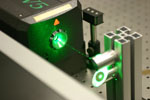Department Faculty Research Areas
Get involved in research! Our faculty conduct fascinating research in areas such as astrophysics, femtosecond lasers, materials science, and optoelectronics.
Spiral Galaxies in Different Environments
Professor Adriana Durbala’s research involves photometric studies of Sloan Digital Sky Survey (
www.sdss.org) images of galaxies obtained with a 2.5-m telescope. She also uses interferometric data obtained with a Fabry-Pérot instrument attached to the 2.1-m telescope at San Pedro Mártir in Baja California. Her photometric studies of spiral galaxies in different types of environments (isolated, compact groups and interacting pairs) aim at describing the properties of bulges (classical and pseudobulges), disks, bars and spiral arms.
Phenomenology of Active Galactic Nuclei
Professor Sebastian Zamfir uses optical spectra from Sloan Digital Sky Survey (
www.sdss.org) to investigate the properties of the central engines in active galactic nuclei (AGN). His is also interested in a search for systematic differences between radio-loud and radio-quiet quasars.
Nanoscale Magnetism
Dr. Palash Banerjee employs scanning probe microscopy to examine magnetic effects in materials at nanometer length scales.
Superconductivity
Dr. Brad Hinaus studies how the entrance of magnetic vortices affects the superconducting properties of high temperature superconducting grain boundaries. Superconductors exhibit zero resistance with a transition to a non-resistive state. The resistive transition is measured using an Ohm’s law type setup as studied in most introductory labs. The resistive transition of the superconducting grain boundary is measured at the temperature and the magnetic field is varied.
Optoelectronics
Dr. Maryam Farzaneh’s research explores the effects of temperature and heat flow in optoelectronic and electronic devices at the microscale and under operating conditions. You can
find out more about her research here.
Photoelectrochemical water splitting
Dr. Ken Menningen’s research aims to improve the technology that allows a semiconductor to split water into hydrogen and oxygen using only sunlight.
Femtosecond Lasers

The laser system in Dr. Chris Verzani’s laboratory is capable of producing pulses of light lasting only 10 femtoseconds (10
−14 s). The pulses are produced by a
KMLabsTitanium-doped sapphire (solid-state) laser which is “pumped” by the green light from a 5-watt
Coherent Verdi laser. Ultrashort laser pulses have many applications in telecommunications, medicine, industry, and basic scientific research. The equipment in this lab is used to study the ultrafast dynamics of charges in materials.
RELEVANT RESEARCH
Summer Undergraduate Research Opportunities
The Department of Physics and Astronomy receives information about research experiences for undergraduates from various programs throughout the year. Please talk to your adviser about how options listed here might complement your academic journey. Junior and senior level students have participated in a variety of summer programs at institutions such as Argonne and Brookhaven National Laboratories, Marshfield Clinic, Lucent Technologies, and the Universities of Notre Dame, Minnesota, Rochester, and Nevada-Las Vegas.
(examples)
- National Science Foundation – The NSF has an REU database that is searchable by either area of research or geographic area. Start here!
- Department of Energy – DOE Scholars Program: The DOE Scholars Program offers unique opportunities that introduce students or post-graduates to the agency’s missions and operations. Appointments are available in a variety of disciplines at participating DOE facilities nationwide.
- Maine Space Consortium Webpage lists opportunities for students from grades K-12 up to graduate students.
- NASA – The Office of Education Infrastructure Division Launchpad has searchable student opportunities such as fellowships, internships, and scholarships as well as information regarding recruitment events.
- DAAD RISE – Research Internships in Science and Engineering in Germany. Open to non-US citizens.
- The American Physical Society has a list of undergraduate (and graduate) fellowships.
- Society of Physics Students
- American Association for the Advancement of Science (AAAS)
- The Nucleus – This site has many listings for REUs, along with other resources for physics and astronomy undergraduates. There is a Research Listings search box in the upper left corner of the home page.
- Pathways to Science – The Institute for Broadening Participation (IBP) has a searchable index of over 650 paid summer research and internship programs in the STEM fields.
- Michigan State University Library – The MSU library maintains a searchable database of funding opportunities for individuals, including both research support and scholarships.